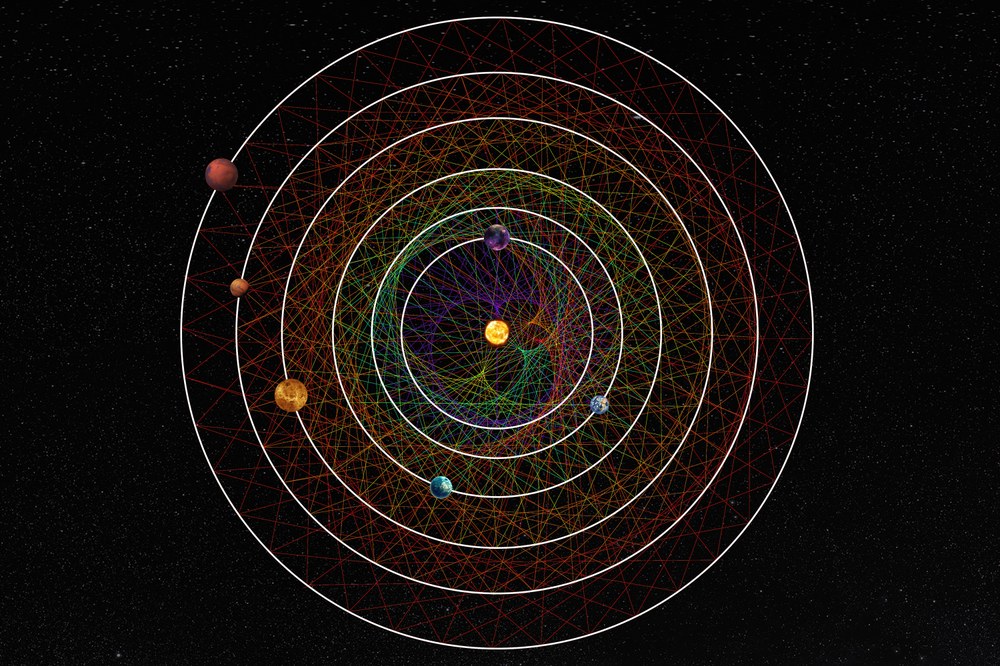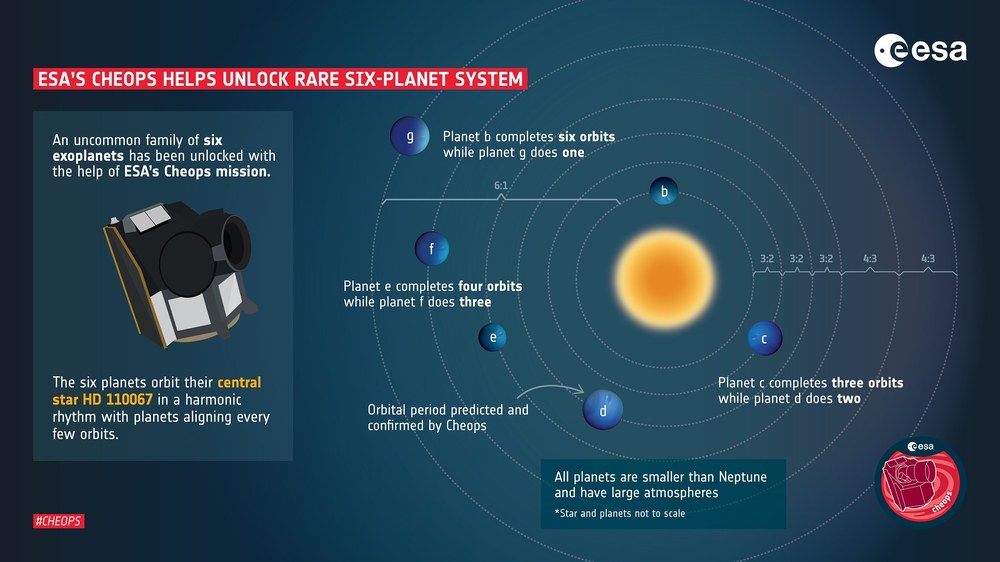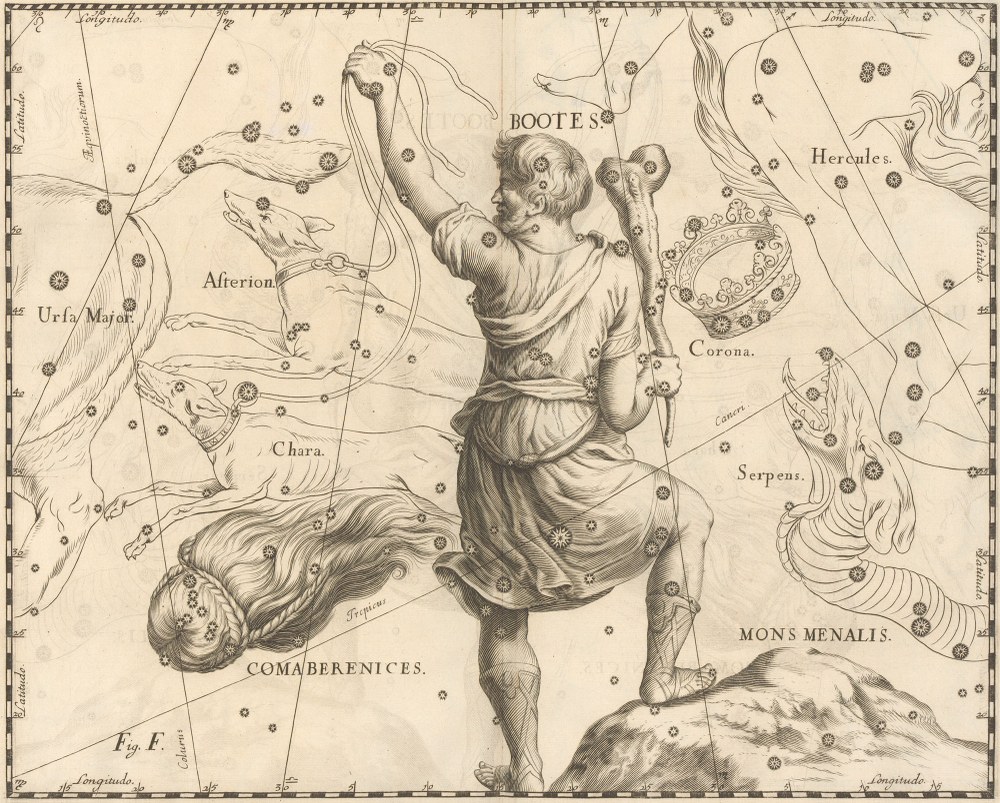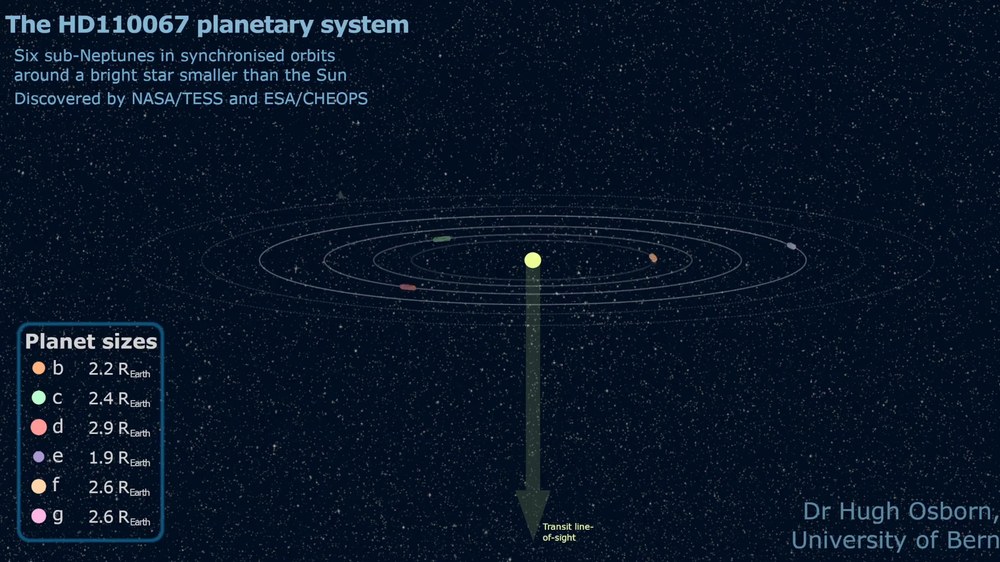Six planets in resonance in the constellation 'Coma Berenices'

Thibaut Roger/NCCR PlanetS, CC BY-NC-SA 4.0

ESA

Prodromus Astronomiae
- The star HD 110067 is orbited by six planets that revolve around the central star in resonance with one another.
- Harmonic resonances like this indicate that this planetary system has remained unchanged since its formation.
- The discovery was made with the transit method, using the combination of light curve measurements acquired by the TESS and CHEOPS space telescopes.
- Focus: Space, exoplanets, astronomy, space telescopes
Most people associate octaves, fifths and fourths with harmonic sounds whose frequencies are in a well-defined, whole-number ratio – 2:1 for the octave, 3:2 for the fifth and 4:3 for the fourth. In 1609, Johannes Kepler described the harmonic relationship of the orbits and orbital periods of the Solar System planets in his work 'Harmonices mundi libri V' (Five Books on the Harmonics of the World). In the newly discovered exoplanet system around the star HD 110067, such harmonic relationships are also found in the orbital periods of six planets. This indicates that the system has likely remained unaltered since its formation more than a billion years ago. These planets were not discovered with a single observation but through a combination of data from two different telescopes. The discovery and comprehensive characterisation of the planetary sextet reads like a detective story. It has now been published in the scientific journal Nature, with personnel from the German Aerospace Center (Deutsches Zentrum für Luft- und Raumfahrt; DLR) being part of the team.
Multi-planet systems are ideal for testing models of the formation and evolution of planets. The six exoplanets that have now been discovered and characterised around HD 110067 have diameters between those of Earth (approximately 12,750 kilometres) and Neptune (just under 50,000 kilometres, or four Earth diameters) – hence the name sub-Neptune. They orbit a star that is 104 light years away from the Solar System, and is about 80 percent the size of our Sun both in terms of its diameter and mass. The study involved 140 scientists, including five from the DLR Institute of Planetary Research in Berlin-Adlershof. The lead author is astrophysicist Rafael Luque from the University of Chicago.

Animation – Harmonic relationships in the planetary system HD 110067
Your consent to the storage of data ('cookies') is required for the playback of this video on Quickchannel.com. You can view and change your current data storage settings at any time under privacy.
Hugh Osborne (University of Bern)
TESS and CHEOPS performed the measurements
In spring 2020, NASA's Transiting Exoplanet Survey Satellite (TESS) first became aware of fluctuations in the brightness of star HD 110067 when measuring a portion of the sky referred to as 'sector 23'. These dips in brightness were attributed to two planet candidates, or 'TESS Objects of Interest' (TOI). Two years later, in February and March 2022, TESS observed another celestial field, sector 49, which overlapped with sector 23 where the same star was located. From the combined data, researchers deduced that two planets were indeed orbiting the star. The first planet, HD 110067 b (the first planet discovered around another star is always assigned the letter 'b'), completes a full orbit every 9.114 days while the second planet, HD 110067 c, had an orbital period of 13.673 days. However, there was more going on around this star than the researchers could gather at the time.
Observations by ESA's CHaracterising ExOplanet Satellites (CHEOPS) space telescope, launched in 2019, have shed more light on this mystery. "With CHEOPS, we were able to observe the star specifically at the times when transit events were expected," explains Alexis M. S. Smith, one of the DLR authors and scientists on the CHEOPS Science Team. "This was then the key to further interpretation of the system." CHEOPS data confirmed a third planet, HD 110067 d, which takes 20.519 days to orbit its star (for a comparison with our own Solar System, the innermost planet Mercury has an orbital period of 88 days). By looking at the orbital periods of these three exoplanets, it was found that they are in a ratio of 3 to 2; in the time it takes for planet 'b' to complete three orbits around its star, planet 'c' has completed two; and once planet 'c' has orbited three times, planet 'd' has orbited twice. All three planets therefore have orbital periods in 'whole-number resonance ratios', which in this case corresponds to a fifth in the harmonic theory of music.
However, in the data of each TESS sector were further dips in the recorded strength of its starlight over a certain period – its light curve – and thus an indication of more 'transit events', such as other possible planets passing in front of the star that could not be identified. Assuming their orbits might also follow the same harmonic arrangement, two transits observed in the different TESS sky sectors – and thus widely separated in time – could be assigned to a fourth planet, HD 110067 e, with an orbital period of 30.8 days – again in a 3:2 ratio with planet 'd'.
Resonances akin to Mozart's 'Eine kleine Nachtmusik'
Two more individual transits were found in 'sector 49' that were thought to be caused by two additional orbiting planets, 'f' and 'g'. Assuming mathematically stable orbits and trying possible combinations of orbital periods, two planets indeed fit into the acquired TESS data: HD 110067 f with an orbital period of 41.0 days and HD 110067 g with an orbital period of 54.7 days. The ratio of the orbital periods of the planets f and e, and that between the planets g and f, show a resonance of 4:3. From a musical point of view, this is a fourth, which, for example, comes into its own as the famous 'pure' fourth in Mozart's 'Eine kleine Nachmusik' (A Little Night Music).
The transits of the two final planets should have been seen earlier, during the TESS observations of sector 23. However it turned out that a lot of scattered light from Earth and the Moon reached the detector during these periods, resulting in a high level of disruptive background noise that prevented the planetary signals from being recognised. Normally such images are discarded, but a new analysis of the data with the two planets predicted transit times revealed the dips in the light curves.
Such old, unchanged planetary systems are extremely rare
The harmonious multi-planet system that has been discovered around HD 110067 is not the first of its kind. However, it is extremely rare to find systems like this in which the orbital resonance of so many planets have been preserved simultaneously over such a long period. Based on observations and models, only about one percent of all planetary systems retain their original resonance.
The continued harmonic arrangement of these planetary orbits rules out a major disturbance to the system during the last billion years and can therefore provide information about the formation and development of planetary systems. As HD 110067 is a very bright dwarf star – magnitude eight – this system in the constellation 'Coma Berenices' will also be a highly interesting observational target in the future and will probably soon be observed more closely with the James Webb telescope.
Rafael Luque et al: A resonant sextuplet of sub-Neptunes transiting the bright star HD 110067, Nature, 623, 932-937 (2023), https://doi.org/10.1038/s41586-023-06692-3
About the constellation
The constellation Coma Berenices is visible above Earth's northern hemisphere, located between the constellations Leo, Virgo and Ursa Major. It is comparatively inconspicuous; the main star is Diadem (alpha Coma Berenices). Compared to the much better-known constellations like the Big Dipper, Orion (the most prominent winter constellation) or the 12 constellations of the zodiac such as Aries or Scorpio, the somewhat enigmatic, exotic name of this constellation is striking. The Latin name Coma Berenices means Berenice's Hair.
So, who was Berenice, after whom this constellation is named? Berenice of Cyrene was the cousin and then wife of the Egyptian king Ptolemy III and lived from 270 to 221 BC. The anecdote from antiquity says that Berenice made a vow to cut off her hair if her husband returned victorious from the war against the Syrians, to which he set off on the day after their wedding. And so, it happened Berenice – which also means 'the one who brings victory'– sacrificed her tresses on the altar of Aphrodite in Aswan.
The next day, however, the hair had disappeared, and legend has it that the court astronomer quickly interpreted the situation, which had now naturally become somewhat delicate in the royal house, as follows. The gods had taken possession of the beautiful hair and moved it to the heavens out of delight at the good fortune in the war and admiration for Berenice's willingness to make sacrifices. There it can now be gazed at by everyone. Berenice's hair is the only one of today’s 88 constellations to be named after a historical person. The stars were of course already there before this event and formed the tail tassel of the neighbouring 'Lion'.
